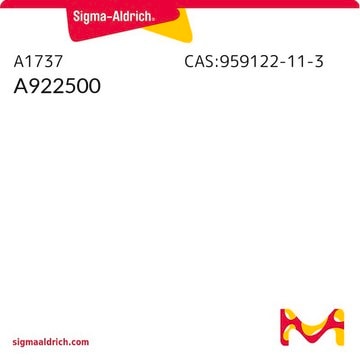PZ0233
PF-06424439
≥98% (HPLC)
Synonym(s):
[(3R)-1-[2-[1-(4-Chloro-1H-pyrazol-1-yl)cyclopropyl]-3H-imidazo[4,5-b]pyridin-5-yl]-3-piperidinyl]-1-pyrrolidinyl-methanone methanesulfonate
About This Item
Recommended Products
Assay
≥98% (HPLC)
form
powder
optical activity
[α]/D +7 to +11°, c = 1.0 in methanol
color
white to light brown
solubility
H2O: 10 mg/mL, clear
storage temp.
room temp
SMILES string
O=C([C@@H]1CCCN(C2=NC(NC(C3(CC3)N4N=CC(Cl)=C4)=N5)=C5C=C2)C1)N6CCCC6.CS(=O)(O)=O
InChI
1S/C22H26ClN7O.CH4O3S/c23-16-12-24-30(14-16)22(7-8-22)21-25-17-5-6-18(26-19(17)27-21)29-11-3-4-15(13-29)20(31)28-9-1-2-10-28;1-5(2,3)4/h5-6,12,14-15H,1-4,7-11,13H2,(H,25,26,27);1H3,(H,2,3,4)/t15-;/m1./s1
InChI key
ZSTFDNQQOJUJFL-XFULWGLBSA-N
Application
- to study its effects on cell mortality and lipid synthesis in epithelial colon cells and colorectal cancer stem cells
- to study its effects on HeLa cells
- to study its inhibitory effects on neutral lipid synthesis in HT-1080 cells
Biochem/physiol Actions
Storage Class Code
11 - Combustible Solids
WGK
WGK 3
Flash Point(F)
Not applicable
Flash Point(C)
Not applicable
Certificates of Analysis (COA)
Search for Certificates of Analysis (COA) by entering the products Lot/Batch Number. Lot and Batch Numbers can be found on a product’s label following the words ‘Lot’ or ‘Batch’.
Already Own This Product?
Find documentation for the products that you have recently purchased in the Document Library.
Customers Also Viewed
Articles
Discover Bioactive Small Molecules for Lipid Signaling Research
Discover Bioactive Small Molecules for Lipid Signaling Research
Discover Bioactive Small Molecules for Lipid Signaling Research
Discover Bioactive Small Molecules for Lipid Signaling Research
Our team of scientists has experience in all areas of research including Life Science, Material Science, Chemical Synthesis, Chromatography, Analytical and many others.
Contact Technical Service










